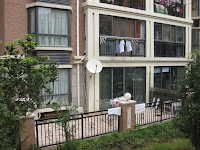 This past week I had the unique opportunity to be a guest speaker at the Les Roches Jin Jiang International Hotel Management College. One of my good friends is a lecturer for the college and knowing my background in hospitality, invited me to come speak. The day was interesting as I made a presentation to five different classes about my various experiences in hospitality. I was honored to accept this invitation as it allowed me to share my experiences of graduating from Florida State University's Dedman School of Hospitality. I gave the students a valuable insight into our program at Florida State and furthered my knowledge of hospitality education by observing one of the China's top hospitality schools.
This past week I had the unique opportunity to be a guest speaker at the Les Roches Jin Jiang International Hotel Management College. One of my good friends is a lecturer for the college and knowing my background in hospitality, invited me to come speak. The day was interesting as I made a presentation to five different classes about my various experiences in hospitality. I was honored to accept this invitation as it allowed me to share my experiences of graduating from Florida State University's Dedman School of Hospitality. I gave the students a valuable insight into our program at Florida State and furthered my knowledge of hospitality education by observing one of the China's top hospitality schools.  Shanghai Normal University, located in the Southeast part of Shanghai, oversees the college and has teamed up with Les Roches, a famous Swiss-based hospitality school, and Jin Jiang, China’s largest hotel management company, to run the program. Les Roches has been named one of the top three hospitality schools in the world and currently operates five campuses worldwide. The hospitality program here in Shanghai allows students to complete their two-year associate degree before transferring to Les Roches’ main campus in Switzerland to finish their bachelor’s degree.
Shanghai Normal University, located in the Southeast part of Shanghai, oversees the college and has teamed up with Les Roches, a famous Swiss-based hospitality school, and Jin Jiang, China’s largest hotel management company, to run the program. Les Roches has been named one of the top three hospitality schools in the world and currently operates five campuses worldwide. The hospitality program here in Shanghai allows students to complete their two-year associate degree before transferring to Les Roches’ main campus in Switzerland to finish their bachelor’s degree. Over 95% of the students enrolled in the program are Mainland Chinese with the college opening its doors to foreign students just two years ago. In 2008 a total of 5 foreigners enrolled in the program with this number now increased to 27 in 2009. Students are now coming from all over the world to start their hospitality career in China and during my one-day visit I was able to meet with students from each of the following countries: Germany, Spain, Sweden, Panama, Russia, and Kazakhstan.
One of the biggest attractions for the Mainland Chinese is the opportunity to finish the program in Switzerland. This gives them valuable international experience that will set them apart from their peers in the industry. The first step for all students is to pass the IELTS exam (International English Language Testing System). Upon enrollment in the college, students are separated into five different levels depending on their English proficiency. 
#1 – A modern casual café with outdoor seating providing coffee and small snacks
#2 – The formal dinning room staffed by students in the program
#3 – The main dining room features a buffet lunch everyday. This is where students and faculty eat their lunch everyday.
I felt the strongest advantage of the program is its ability to give students ample “hands on” experience. Students rotate through all departments of the school gaining valuable experience in the Front-of-House (FOH) operations serving as servers and server assistants as well as the Back-of-House (BOH) operations by prepping, cooking, and plating the food for each campus restaurant The school’s Executive Chef Francois Chevallier of France oversees the kitchen operations and together with an Australian Sous Chef educate the students on the culinary aspects of the industry.
#1 – A team of student chefs work together to prepare the food for the day's lunch buffet
#2 – A poster on one of the walls as seen in the hallways of the college
#3 – Student hanging out in the recreation room, playing ping pong with one of their professors
The purpose of my visit was to give students an insight into another sector of the vast hospitality industry by telling them of my experiences of working in China’s rapidly growing golf industry. Similar to our program at Florida State, one of the college’s main attractions is a 95% job placement after graduation. This is critical for a college in an extremely populated country like China.












































